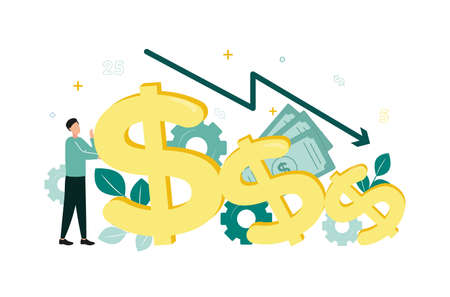What Are Minimum Payments?
When you use a credit card or take out a loan in the United States, lenders give you the option to pay a “minimum payment” each month. This is the smallest amount of money you need to pay by your due date to keep your account in good standing and avoid late fees. Minimum payments are designed to make monthly payments manageable, but they don’t help you pay off your debt quickly. For credit cards, minimum payments are usually calculated as a small percentage of your total balance—often around 1% to 3%—plus any interest charges and fees. For loans, such as personal or auto loans, the minimum payment is typically a fixed monthly amount that covers both principal and interest. While making only the minimum payment can seem convenient if you’re tight on cash, it’s important to understand how this practice can keep you in debt much longer and cost you more in interest over time.
2. How Minimum Payments Affect Your Debt
When you make only the minimum payment on your credit card, it might feel like youre keeping your finances under control. However, this approach can actually keep you in debt much longer than you expect. The minimum payment is usually calculated as a small percentage of your total balance—sometimes just 1% to 3%—plus interest and fees. Because of this, most of your payment goes toward interest, not the principal amount you owe.
Why Does This Matter?
Let’s break it down: if you only pay the minimum each month, your balance shrinks very slowly while interest keeps adding up. Over time, youll end up paying far more than what you originally borrowed. Here’s a simple example to illustrate how long and costly it can get:
| Credit Card Balance | Interest Rate (APR) | Minimum Payment (% of Balance) | Time to Pay Off | Total Interest Paid |
|---|---|---|---|---|
| $5,000 | 18% | 2% | ~30 years | $8,500+ |
The Real Cost of Minimum Payments
If you stick with the minimum payment, your monthly obligation might feel manageable now, but over the years you could pay almost double—or even more—than your original purchase. Thats money that could be better spent on building savings or investing for your future.
A Friendly Tip
If possible, always aim to pay more than the minimum each month—even a little extra helps! By doing so, you’ll shorten your payoff timeline and save a significant amount in interest charges. Remember, understanding how minimum payments work empowers you to make smarter financial choices and break free from the cycle of debt.

3. Why Lenders Love Minimum Payments
If youve ever wondered why credit card companies make it so easy to pay just the minimum each month, youre not alone. The truth is, minimum payments are a big part of their business model—and its all about maximizing profit. By encouraging you to pay only a small portion of your balance, lenders ensure that you carry debt for a longer period. This means more interest accrues on your outstanding balance, and that’s where the real money is made.
From a lender’s perspective, minimum payments are a win-win: they reduce the risk of default by keeping your account in good standing, while also generating steady revenue through interest charges. For example, if you have a $5,000 balance and only pay the minimum each month, it could take years to pay off—and you might end up paying double or even triple the original amount in interest alone. Credit card companies design their statements to highlight the minimum due because they know many people will choose this seemingly manageable option over paying the full balance.
It’s important to recognize that this system is intentionally structured to keep you as a long-term customer with ongoing debt. The longer it takes to pay down your balance, the more profit credit card companies make from your account. Understanding this can help you make smarter choices and avoid falling into the trap of endless interest payments.
4. The Cycle of Debt: Real-Life Examples
To truly understand why minimum payments can keep you trapped in debt, lets look at some everyday American scenarios. Many people think they’re managing their credit card balances responsibly by paying just the minimum required each month. However, this approach often leads to a cycle that is hard to break—especially when unexpected expenses pop up or interest rates climb.
How Minimum Payments Trap You: Two Common Scenarios
| Scenario | Starting Balance | Monthly Minimum Payment (2%) | Interest Rate (APR) | Time to Pay Off | Total Interest Paid |
|---|---|---|---|---|---|
| Alice’s Emergency Expense | $3,000 | $60 | 20% | Over 16 years* | $4,800+ |
| Mike’s Everyday Purchases | $8,000 | $160 | 18% | Over 30 years* | $15,000+ |
*Assumes no new charges and only minimum payments every month.
Alice’s Story: The Unexpected Car Repair
Alice used her credit card for a $3,000 car repair. She could only afford to pay the minimum each month. Because most of her payment went toward interest, it took her over 16 years to pay off this single emergency expense—costing her more than she ever expected in interest alone.
Mike’s Story: The Gradual Build-Up
Mike used his card for everyday purchases—groceries, gas, and small treats—which slowly added up to $8,000. By only making the minimum payments, he found himself on track to pay for decades, with total interest costs nearly doubling what he borrowed.
The Takeaway: Why Paying Only the Minimum Isn’t Enough
These examples show how easy it is to fall into the debt cycle in America. While minimum payments offer short-term relief, they extend your debt repayment timeline and dramatically increase your total interest paid. Understanding these real-life scenarios is the first step toward breaking free from long-term debt and taking control of your financial future.
5. Smart Strategies to Break the Cycle
If you’re ready to move beyond just making minimum payments, you’re already on the right track! Here are some friendly and practical tips to help you pay down debt faster and start building healthier financial habits.
Pay More Than the Minimum—Even a Little Helps
Whenever possible, try to pay more than the required minimum each month. Even a small extra amount can make a big difference over time by reducing your principal balance and cutting down interest costs.
Create a Simple Debt Repayment Plan
Consider using popular strategies like the snowball method (paying off your smallest balances first) or the avalanche method (tackling debts with the highest interest rates). Both methods help you build momentum and stay motivated as you see real progress.
Automate Your Payments
Setting up automatic payments not only ensures you never miss a due date but can also help you stick to your plan of paying more than the minimum. It’s a set-it-and-forget-it way to keep your finances on track.
Cut Expenses and Redirect Savings
Take a look at your monthly spending and see where you can trim unnecessary expenses. Redirect those savings toward your debt repayment—it all adds up! Every little bit brings you closer to financial freedom.
Seek Help When You Need It
If you’re feeling overwhelmed, don’t hesitate to reach out for help. Nonprofit credit counseling agencies offer free or low-cost advice and can help you create a plan that works for your unique situation.
Remember, breaking free from the cycle of minimum payments isn’t about depriving yourself—it’s about taking control and creating a future where your money works for you. With these smart strategies, you’ll be well on your way to a healthier financial life!


